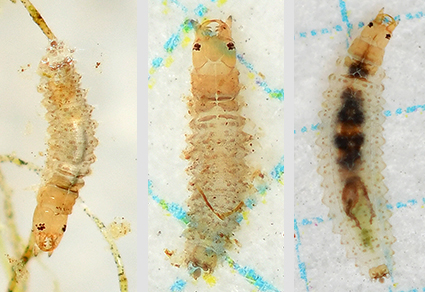Abstract
The generic and species identity of previously described larva of Paracymus aeneus (Germar, 1824), the type species of the genus Paracymus Thomson, 1867, has been a subject of controversy owing to their morphological similarity to the genus Anacaena Thomson, 1859. In this study, we describe morphology of the egg-case and all three instar larvae of P. aeneus based on Japanese specimens obtained through rearing and provide the biological information on the species under rearing conditions. The morphology of the larvae corresponds with that of known Paracymus larvae rather than Anacaena. Consequently, larvae previously described as P. aeneus do not belong this species. Therefore, this is the first description of the immature stages of P. aeneus.
References
- Archangelsky, M. (1997) Studies on the biology, ecology, and systematics of the immature stages of New World Hydrophiloidea (Coleoptera: Staphyliniformia). Bulletin of the Ohio Biological Survey, New Series, 12, 1–207.
- Archangelsky, M. (1999) Immature stages of Paracymus rufocinctus Bruch, 1915 and Enochrus (Methydrus) vulgaris (Steinheil, 1869) (Coleoptera: Hydrophilidae: Hydrophilinae). Elytron, 13, 87–99.
- Archangelsky, M. & Fikáček, M. (2004) Descriptions of the egg case and larva of Anacaena and a review of the knowledge and relationships between larvae of Anacaenini (Coleoptera: Hydrophilidae: Hydrophilinae). European Journal of Entomology, 101 (4), 629–636. https://doi.org/10.14411/eje.2004.086
- Bøving, A.G. & Henriksen, K.L. (1938) The developmental stages of the Danish Hydrophilidae (Ins., Coleoptera). Videnskabelige Meddelelser fra Dansk Naturhistorisk Forening i København, 102, 27–162.
- Byttebier, B. & Torres, P.L.M. (2009) Description of the preimaginal stages of Enochrus (Hugoscottia) variegatus (Steinheil, 1869) and E. (Methydrus) vulgaris (Steinheil, 1869) (Coleoptera: Hydrophilidae), with emphasis on larval morphometry and chaetotaxy. Zootaxa, 2139 (1), 1–22. https://doi.org/10.11646/zootaxa.2139.1.1
- Fikáček, M. (2006) Primary Chaetotaxy of the Larval Head of the Hydrophiloid Beetles (Coleoptera: Hydrophiloidea). Unpublished MSc thesis, Charles University, Praha, 221 pp.
- Fikáček, M., Angus, R.B., Gentili, E., Jia, F.-L., Minoshima, Y.N., Prokin, A., Przewoźny, M. & Ryndevich, S.K. (2015) Family Hydrophilidae Latreille, 1802. In: Löbl, I. & Löbl, D. (Eds.), Catalogue of Palaearctic Coleoptera. Vol. 2. Revised and Updated Edition, Hydrophiloidea – Staphylinoidea. Brill, Leiden, pp. 37–76.
- Fikáček, M., Archangelsky, M. & Torres, P.L.M. (2008) Primary chaetotaxy of the larval head capsule and head appendages of the Hydrophilidae (Coleoptera) based on larva of Hydrobius fuscipes (Linnaeus, 1758). Zootaxa, 1874 (1), 16–34. https://doi.org/10.11646/zootaxa.1874.1.2
- Fikáček, M., Gustafson, G.T. & Short, A.E.Z. (2017) On wet rocks with snorkels: immature stages of Tritonus cascade beetles with unusual modification of spiracles (Coleoptera: Hydrophilidae: Laccobiini). Annales Zoologici, 67 (1), 91–107. https://doi.org/10.3161/00034541ANZ2017.67.1.011
- Fikáček, M., Minoshima, Y., Vondráček, D., Gunter, N. & Leschen, R.A.B. (2013) Morphology of adults and larvae and integrative taxonomy of southern hemisphere genera Tormus and Afrotormus (Coleoptera: Hydrophilidae). Acta Entomologica Musei Nationalis Pragae, 53 (1), 75–126.
- Gould, J. & Valdez, J.W. (2021) Locomotion with a twist: Aquatic beetle walks upside down on the underside of the water's surface. Ethology, 127 (8), 669–673. https://doi.org/10.1111/eth.13203
- Hansen, M. (1999) World Catalogue of Insects 2: Hydrophiloidea (s. str.) (Coleoptera). Apollo Books, Amsterdam, 416 pp. https://doi.org/10.1163/9789004629042_004
- Kurosawa, Y. (1987) [The strange behaviour of Regimbartia attenuata (Fabricius)]. Coleopterists’ News, 75/76, 10. [in Japanese]
- Matsuno, T. (1989) [Hydrocassis lacustris Sharp walking on the underside of the water surface]. Coleopterists’ News, 86, 3. [in Japanese]
- Minoshima, Y.N., Fikáček, M. & Liu, H.-C. (2023) Larval morphology of Crephelochares and Peltochares (Coleoptera: Hydrophilidae). Acta Entomologica Musei Nationalis Pragae, 63 (2), 305–322. https://doi.org/10.37520/aemnp.2023.019
- Minoshima, Y. & Hayashi, M. (2011) Larval morphology of the Japanese species of the tribes Acidocerini, Hydrobiusini and Hydrophilini (Coleoptera: Hydrophilidae). Acta Entomologica Musei Nationalis Pragae, 51 (Supplementum), 1–118.
- Richmond, E.A. (1920) Studies on the biology of the aquatic Hydrophilidae. Bulletin of the American Museum of Natural History, 42, 1–94, pls. 1–16. https://doi.org/10.5962/bhl.title.60200
- Rodriguez, G., Fikáček, M., Minoshima, Y.N., Archangelsky, M. & Torres, P.L.M. (2020) Going underwater: multiple origins and functional morphology of piercing-sucking feeding and tracheal system adaptations in water scavenger beetle larvae (Coleoptera: Hydrophiloidea). Zoological Journal of the Linnean Society, 193 (1), 1–30. https://doi.org/10.1093/zoolinnean/zlaa132
- Shirayama, Y., Kaku, T. & Higgins, R.P. (1993) Double-sided microscopic observation of meiofauna using an HS-slide. Benthos Research, 44, 41–44. [in Japanese] https://doi.org/10.5179/benthos1990.1993.44_41
- Short, A.E.Z. & Fikáček, M. (2011) World catalogue of the Hydrophiloidea (Coleoptera): additions and corrections II (2006–2010). Acta Entomologica Musei Nationalis Pragae, 51 (1), 83–122.
- Short, A.E.Z. & Fikáček, M. (2013) Molecular phylogeny, evolution and classification of the Hydrophilidae (Coleoptera). Systematic Entomology, 38 (4), 723–752. https://doi.org/10.1111/syen.12024
- Short, A.E.Z. & Hebauer, F. (2006) World catalogue of Hydrophiloidea – additions and corrections, 1 (1999–2005) (Coleoptera). Koleopterologische Rundschau, 76, 315–359.
- Takahashi, R. (1922) [The behaviours of Amphiops mater Sharp and aquatic insects that orient their dorsal side downwards]. Zoological Magazine, 34, 77–79. [in Japanese]
- Toussaint, E.F.A., Fikáček, M. & Short, A.E.Z. (2016) India–Madagascar vicariance explains cascade beetle biogeography. Biological Journal of the Linnean Society, 118 (4), 982–991. https://doi.org/10.1111/bij.12791
- Toussaint, E.F.A. & Short, A.E.Z. (2018) Transoceanic Stepping–stones between Cretaceous waterfalls? The enigmatic biogeography of pantropical Oocyclus cascade beetles. Molecular Phylogenetics and Evolution, 127, 416–428. https://doi.org/10.1016/j.ympev.2018.04.023
- Winterbourn, M.J. (1973) The larva of Anacaena tepida (Coleoptera: Hydrophilidae) from a Rotorua hot spring. New Zealand Entomologist, 5 (2), 171–174. https://doi.org/10.1080/00779962.1973.9722992


